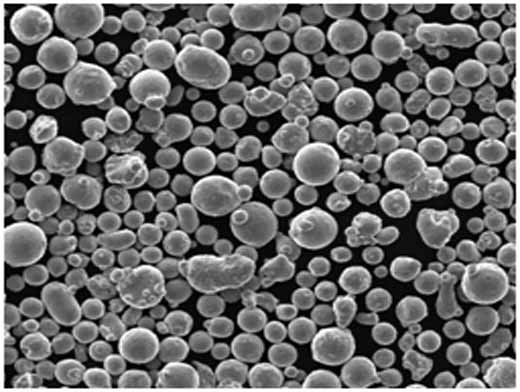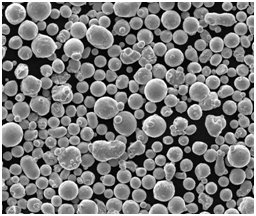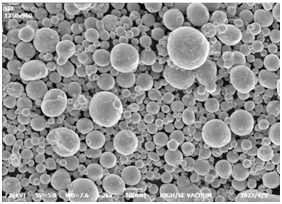개요 바인더 제트 3D 프린팅
바인더 제트 3D 프린팅(BJ3DP)은 복잡하고 강도가 높은 금속 부품을 대규모로 생산하는 능력이 돋보이는 최첨단 적층 제조 공정입니다. 다른 3D 프린팅 기술과 달리 바인더 제팅은 재료를 녹이지 않으므로 생산 시간을 단축하고 에너지 소비를 줄이며 광범위한 재료, 특히 금속 분말로 작업할 수 있습니다.
이 기술은 정밀성, 효율성 및 재료 유연성이 중요한 산업 분야에서 특히 유리합니다. 항공우주, 자동차 또는 의료 분야에서든 바인더 제트 3D 프린팅은 복잡한 금속 부품 생산을 위한 비용 효율적이고 확장 가능한 솔루션을 제공하여 파장을 일으키고 있습니다.
바인더 제트 3D 프린팅의 과학
바인더 제팅은 비교적 간단한 원리로 작동합니다. 액체 접착제인 바인더는 층별로 분말층에 선택적으로 증착됩니다. 바인더가 적용된 영역은 원하는 모양을 형성하기 위해 경화되는 반면, 주변 분말은 느슨하게 유지되어 재사용할 수 있습니다. 물체가 완전히 형성되면 소결과 같은 후처리 단계를 거쳐 최종 밀도와 강도를 얻습니다.
바인더 제트 3D 프린팅은 어떻게 작동합니까?
- 1단계: 분말 적층: 금속 분말의 얇은 층이 빌드 플랫폼에 펼쳐집니다.
- 2단계: 바인딩: 프린트 헤드는 바인더를 분말에 선택적으로 증착하여 부품의 모양을 형성합니다.
- 3단계: 반복: 전체 부품이 제작될 때까지 이
- 4단계: 경화: 바인더를 굳히기 위해 부품을 경화시킵니다.
- 5단계: 소결: 최종 단계는 용광로에서 부품을 가열하여 분말 입자를 융합시켜 원하는 기계적 특성을 얻는 것입니다.

바인더 제트 3D 프린팅의 주요 특징
| 특징 | 설명 |
|---|---|
| 소재의 다양성 | 스테인리스강, 티타늄, 인코넬을 포함한 광범위한 금속 분말과 함께 작동합니다. |
| 속도 | 재료를 녹일 필요가 없으므로 다른 금속 3D 프린팅 방식보다 빠릅니다. |
| 비용 효율성 | 에너지 소비가 적고 분말을 재사용할 수 있어 운영 비용이 낮습니다. |
| 표면 마감 | 일반적으로 매끄러운 마감을 얻으려면 후처리가 필요합니다. |
| 부품 강도 | 소결 후 전통적으로 제조된 부품과 유사합니다. |
| 확장성 | 여러 부품을 동시에 생산하는 데 적합합니다. |
장점 바인더 제트 3D 프린팅
- 생산 효율성: SLM(Selective Laser Melting)과 같은 방식에 비해 바인더 제팅은 더 빠르고 에너지 소비가 적어 대규모 생산에 이상적입니다.
- 소재 유연성: 강철, 알루미늄, 심지어 세라믹 재료를 포함한 다양한 금속 분말을 사용할 수 있어 다양한 산업에 적합합니다.
- 비용 효율적: 에너지 요구량이 적고 결합되지 않은 분말을 재사용할 수 있으므로 바인더 제팅은 다른 3D 프린팅 방식보다 경제적인 경우가 많습니다.
- 환경 영향: 이 방식은 고에너지 레이저나 전자 빔을 사용하지 않으므로 폐기물이 적고 탄소 발자국이 작습니다.
바인더 제트 3D 프린팅에 사용되는 특정 금속 분말
바인더 제팅은 인상적인 범위의 금속 분말과 함께 작동할 수 있습니다. 아래에서 몇 가지 특정 모델을 살펴보겠습니다.
| 금속 분말 모델 | 설명 |
|---|---|
| 316L 스테인리스 스틸 | 우수한 내식성과 기계적 특성으로 해양 및 의료 분야에 이상적입니다. |
| 17-4 PH 스테인리스 스틸 | 높은 강도와 경도를 제공하며 항공우주 및 군사 분야에서 널리 사용됩니다. |
| 인코넬 625 | 뛰어난 고온 저항성을 가진 니켈 기반 초합금으로 항공우주 산업에서 자주 사용됩니다. |
| 인코넬 718 | 또 다른 니켈 기반 합금으로 산화 및 부식에 매우 강하며 극한 환경에 적합합니다. |
| 코발트-크롬 | 내구성이 매우 뛰어나고 생체 적합성이 뛰어나 치과 및 정형외과 임플란트에 적합합니다. |
| 구리 | 우수한 전기 및 열 전도성을 제공하며 전자 제품 및 열교환기에 사용됩니다. |
| 티타늄 Ti6Al4V | 가볍고 강도가 높으며 내식성이 뛰어나 항공우주 및 의료 임플란트에 일반적으로 사용됩니다. |
| 알루미늄 AlSi10Mg | 가볍고 내구성이 뛰어나 무게 감소가 중요한 자동차 및 항공우주 부품에 이상적입니다. |
| 브론즈 | 내마모성과 낮은 마찰로 베어링 및 부싱에 자주 사용됩니다. |
| 텅스텐 | 고밀도 및 내열성으로 항공우주 등 고온 안정성이 필요한 분야에 적합합니다. |
바인더 제트 3D 프린팅 분말의 구성
| 금속 분말 | 주요 구성 요소 | 속성 |
|---|---|---|
| 316L 스테인리스 스틸 | 철, 크롬, 니켈, 몰리브덴 | 높은 내식성, 우수한 용접성. |
| 17-4 PH 스테인리스 스틸 | 철, 크롬, 니켈, 구리 | 높은 강도, 우수한 경도, 내식성. |
| 인코넬 625 | 니켈, 크롬, 몰리브덴, 니오븀 | 우수한 고온 강도, 내식성. |
| 인코넬 718 | 니켈, 크롬, 철, 니오븀, 티타늄 | 산화 저항성, 고온 안정성. |
| 코발트-크롬 | 코발트, 크롬, 몰리브덴 | 생체 적합성, 내마모성, 높은 강도. |
| 구리 | 구리 | 높은 전기 및 열 전도성. |
| 티타늄 Ti6Al4V | 티타늄, 알루미늄, 바나듐 | 경량, 내식성, 생체 적합성. |
| 알루미늄 AlSi10Mg | 알루미늄, 실리콘, 마그네슘 | 경량, 우수한 기계적 특성. |
| 브론즈 | 구리, 주석 | 낮은 마찰, 내마모성, 부식 방지. |
| 텅스텐 | 텅스텐 | 높은 융점, 고밀도, 강도. |






애플리케이션 바인더 제트 3D 프린팅
바인더 제팅은 다양한 산업 분야에서 사용되며, 각 금속 분말 모델은 고유한 목적을 수행합니다.
| 산업 | 애플리케이션 | 금속 분말 모델 |
|---|---|---|
| 항공우주 | 엔진 부품, 터빈 블레이드 | 인코넬 625, 인코넬 718 |
| 자동차 | 경량 부품, 프로토타입 | 알루미늄 AlSi10Mg, 티타늄 Ti6Al4V |
| 의료 | 정형외과 임플란트, 수술 도구 | 티타늄 Ti6Al4V, 코발트-크롬 |
| 해양 | 내식성 부품 | 316L 스테인리스 스틸 |
| 전자 제품 | 방열판, 커넥터 | 구리 |
| 군대 | 무기 부품, 장갑 | 17-4 PH 스테인리스 스틸 |
| 에너지 | 터빈 블레이드, 핵 부품 | 인코넬 625, 텅스텐 |
| 보석 | 맞춤형 금속 보석 | 청동, 코발트-크롬 |
| 산업 | 베어링, 부싱 | 청동, 316L 스테인리스강 |
| 건설 | 구조 부품, 피팅 | 316L 스테인리스강, 알루미늄 AlSi10Mg |
금속 분말의 사양 및 표준
바인더 제트 3D 프린팅에 사용되는 금속 분말의 사양, 크기 및 표준을 이해하는 것은 최종 제품이 필요한 품질 및 성능 지표를 충족하는지 확인하는 데 중요합니다.
| 금속 분말 모델 | 입자 크기(미크론) | 밀도(g/cm³) | 소결 온도(°C) | 표준 |
|---|---|---|---|---|
| 316L 스테인리스 스틸 | 15-45 | 7.9 | 1250-1400 | ASTM A276, A240 |
| 17-4 PH 스테인리스 스틸 | 20-53 | 7.7 | 1200-1300 | AMS 5604, ASTM A564 |
| 인코넬 625 | 15-45 | 8.4 | 1250-1400 | ASTM B443, B446 |
| 인코넬 718 | 15-53 | 8.19 | 1250-1400 | AMS 5596, ASTM B637 |
| 코발트-크롬 | 10-45 | 8.3 | 1150-1350 | ASTM F75 |
| 구리 | 15-45 | 8.96 | 1080-1125 | ASTM B152 |
| 티타늄 Ti6Al4V | 20-53 | 4.43 | 1250-1400 | ASTM F1472, AMS 4911 |
| 알루미늄 AlSi10Mg | 20-63 | 2.67 | 555-630 | EN 1706, ISO 3522 |
| 브론즈 | 10-45 | 8.7 | 900-950 | ASTM B505 |
| 텅스텐 | 5-45 | 19.3 | 1500-1700 | ASTM B777 |
바인더 제트 3D 프린팅: 장단점
바인더 제트 3D 프린팅의 장점과 단점을 완전히 이해하려면 장단점을 비교하는 것이 필수적입니다.
| 장점 | 단점 |
|---|---|
| 속도: 빠른 생산 공정 | 후처리: 밀도를 높이기 위한 추가 단계가 필요합니다. |
| 소재 유연성: 광범위한 사용 가능한 분말 | 표면 마감: 종종 2차 가공이 필요합니다. |
| 비용 효율성: 낮은 운영 비용 | 힘: 적절한 소결 없이 부품의 밀도가 낮을 수 있습니다. |
| 확장성: 대량 생산에 적합 | 다공성: 다른 방식에 비해 다공성이 높을 수 있습니다. |
| 환경 영향: 낮은 폐기물 생산 | 디자인 제약 조건: 분말 유동성 및 층 접착력에 의해 제한됩니다. |
금속 분말의 주요 공급업체 바인더 제트 3D 프린팅
고품질 금속 분말의 가용성은 바인더 제트 3D 프린팅의 성공에 매우 중요합니다. 다음은 주요 공급업체와 가격 세부 정보입니다.
| 공급업체 | 사용 가능한 금속 분말 모델 | 가격 범위(USD/kg) | 위치 |
|---|---|---|---|
| 호가나스 AB | 316L 스테인리스강, 17-4 PH 스테인리스강 | 50-100 | 스웨덴 |
| GKN 첨가제 | 인코넬 625, 인코넬 718 | 200-400 | 미국 |
| 목수 첨가제 | 티타늄 Ti6Al4V, 코발트-크롬 | 250-500 | 미국 |
| 샌드빅 오스프리 | 알루미늄 AlSi10Mg, 청동 | 60-150 | UK |
| LPW 기술 | 텅스텐, 구리 | 100-250 | UK |
| AP&C | 티타늄 Ti6Al4V, 인코넬 718 | 300-600 | 캐나다 |
| Tekna | 알루미늄 AlSi10Mg, 구리 | 50-200 | 캐나다 |
| Arcam AB | 코발트-크롬, 티타늄 Ti6Al4V | 200-450 | 스웨덴 |
| 에라스틸 | 316L 스테인리스강, 청동 | 80-180 | 프랑스 |
| 파이로제네시스 | 텅스텐, 인코넬 625 | 150-300 | 캐나다 |
다른 3D 프린팅 기술과 바인더 제트 3D 프린팅 비교
생산 요구 사항에 바인더 제팅을 고려할 때는 Selective Laser Melting(SLM) 및 Electron Beam Melting(EBM)과 같은 다른 인기 있는 3D 프린팅 방식과 비교하는 것이 중요합니다.
| 기술 | 속도 | 재료 범위 | 표면 마감 | 비용 | 일반적인 애플리케이션 |
|---|---|---|---|---|---|
| 바인더 제팅 | 거의 | 광범위(금속, 세라믹) | 거칠고 후처리가 필요합니다. | 낮음(에너지 절약으로 인해) | 대량 생산, 프로토타입 제작 |
| 선택적 레이저 용융(SLM) | 보통 | 금속 | 매끄럽고 상세함 | 높음(장비 비용으로 인해) | 항공우주, 의료용 임플란트 |
| 전자 빔 용융(EBM) | 느림 | 제한적(대부분 금속) | 거칠지만 강도가 높음 | 높음(장비 비용으로 인해) | 항공우주, 맞춤형 부품 |

자주 묻는 질문
| 질문 | 답변 |
|---|---|
| 바인더 제트 3D 프린팅에 어떤 재료를 사용할 수 있습니까? | 스테인리스강, 티타늄, 인코넬을 포함하여 광범위한 금속, 세라믹 및 복합 재료를 사용할 수 있습니다. |
| 바인더 제팅이 다른 금속 3D 프린팅 방식보다 빠릅니까? | 예, 일반적으로 재료를 녹일 필요가 없으므로 프로세스 속도가 크게 빨라집니다. |
| 바인더 제트 3D 프린팅은 강한 부품을 생산합니까? | 예, 적절한 소결 후 부품은 기존 제조 방식으로 만든 부품과 유사한 강도를 얻을 수 있습니다. |
| 바인더 제팅을 사용하는 주요 산업은 무엇입니까? | 항공우주, 자동차, 의료 및 전자 산업은 이 기술을 사용하는 주요 분야 중 일부입니다. |
| 바인더 제팅에 항상 후처리가 필요합니까? | 일반적으로 그렇습니다. 부품의 기계적 특성과 마감을 향상시키려면 소결 또는 침투와 같은 후처리가 필요합니다. |
| 바인더 제팅은 다른 방식과 비교하여 비용이 어느 정도입니까? | 일반적으로 에너지 요구량이 적고 분말을 재사용할 수 있으므로 비용 효율적입니다. |

